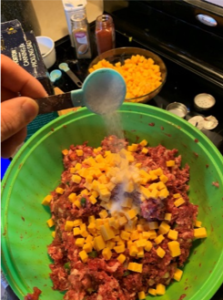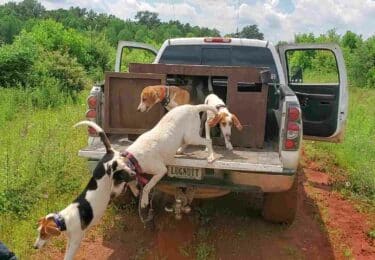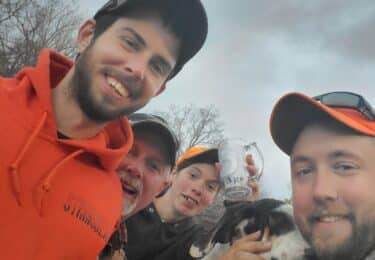Whether you are a beginner or a pro, getting into processing your own wild game meat or have been doing it your whole life, this guide to making kielbasa will have all your friends and family thinking you bought it from a professional meat processing shop! When thinking of how I wanted to convey this information, I decided that the best way to take you on this journey would be to pretend I have never done this in my life and had the minimal equipment to get it done. Now, I have been doing this for quite some time and have all kinds of meat processing equipment these days, but in this step by step guide I will be only using the absolute minimum required items to take a deer leg and turn it into a delicious ring of wild game kielbasa. I will also add some side notes for the folks with more equipment or the ones looking to purchase some new stuff to be able to complete this in bigger bulk or with more efficiency.
Equipment
- Meat Grinder with sausage stuffer attachments (I have a 1 HP Cabelas Carnivore, a ½ HP will do just fine as well)
- Smoker (I have a Masterbuilt Electric Smoker) *Side Note – Depending on your geographic location, temperature, and time of year, you may want to consider what kind of smoker to utilize. I have found that gas powered and larger sized smokers will take much longer (if at all) to get to the temperature required in cold conditions. I switched to a Bluetooth electric smoker and it was life changing when smoking in the winter. Also, if you don’t want the smokey taste, this can also be done right in your oven, making the only needed equipment the meat grinder!
- A food scale
- 2 or 3 large metal bowls
Ingredients
- Meat
- 80% Wild game meat – fat and silver skin completely cut off to the best of your abilities and cubed for grinding (if using bear or wild hog meat, utilize it’s fat at a 95% to 5% ratio)
- 20% Pork Butt – fat left on and cubed for grinding (not needed for wild hog or bear)
- Block of cheddar cheese cut into cubes
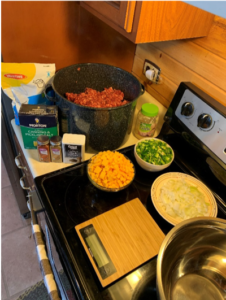
*Side Note – High Temp cheese can be used here, but in my experience it is not needed. The regular cheddar cheese doesn’t typically get hot enough to melt, and when stuffed in the casing in the meat it will stay in its cubed form even if it melts a little while smoking. - Jalapeños diced
- Onions diced
- Minced garlic
- Canning salt
- Black pepper
- Paprika
- Ground Cumin
- Instant non-fat dry milk
- Woodchips (Many different flavors out there, but I typically use hickory or whiskey for this)
- Hog casings
*Side Note – I usually call my local butcher and ask if they would sell me casings. Usually they will, and I buy in bulk and what I don’t use I put into a Ziploc bag, fill it with salt and water, and freeze it for next time. You can also go to a Cabelas or other sportsman store and buy the fake stuff, but it’s just not the same. - Optional: Prague Powder or Pink Salt as it’s sometimes referred to.
*Side Note – I say optional because it’s hard to find and usually has to be ordered, and in my opinion it’s not really needed. The pink salt is basically only used as a preservative and if packaged properly in my experience, the meat can be saved for well over a year in the freezer without it (if it even lasts that long).
Time For The Work To Begin!
The first step in the process is to, of course, kill an animal (we will use a whitetail deer in this example, but most any red meat animal or wild hog will work with this recipe). Ponder on the amount of kielbasa you want to make (typically 1 lb per ring) and add a few extra pounds for sharing with your friends, family, neighbors, or the landowner that let you take the deer on his/her land. When thinking of where I want this meat to come from on the animal, anywhere that you would typically use for burger will do. Front and back legs, rib meat, etc. are good choices.
 Trim all the fat and silver skin off your deer meat, cube it, and grind it. Then take your pork butt and cube and grind that up as well. *Side Note – Due to the fat contents of the pork butt, it may be stringy and cause your grinder to clog up. To alleviate this, first grind the pork butt cubes through larger holes and then grind it again through smaller holes. Once completed, combine and mix the two meats together in a large metal pot or bowl (this is where an electric mixer would come in handy if you don’t want an upper body workout). Once complete, set it in the freezer (or outside if it’s cold) to chill. *Side Note – You always want your meat as cold as possible (but not frozen) when sending it through the grinder. Your grinder will get hot the longer it’s used and can even slightly cook the meat. I also wrap ice packs around the motor to keep it from getting hot. I will let the meat chill in the freezer or outside until it gets to the point where my fingers will instantly get cold when I push them into the meat.
Trim all the fat and silver skin off your deer meat, cube it, and grind it. Then take your pork butt and cube and grind that up as well. *Side Note – Due to the fat contents of the pork butt, it may be stringy and cause your grinder to clog up. To alleviate this, first grind the pork butt cubes through larger holes and then grind it again through smaller holes. Once completed, combine and mix the two meats together in a large metal pot or bowl (this is where an electric mixer would come in handy if you don’t want an upper body workout). Once complete, set it in the freezer (or outside if it’s cold) to chill. *Side Note – You always want your meat as cold as possible (but not frozen) when sending it through the grinder. Your grinder will get hot the longer it’s used and can even slightly cook the meat. I also wrap ice packs around the motor to keep it from getting hot. I will let the meat chill in the freezer or outside until it gets to the point where my fingers will instantly get cold when I push them into the meat. 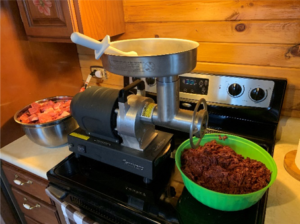
While your meat is chilling, it is time to prepare the rest of the ingredients. Take your casings (thaw if frozen) and put them in a tub of salt water. Let them soak until you are ready to use them (especially if they are dried in a package). Also, take your woodchips that you plan on using (hickory in this case) and soak them in a bowl of water as well. If you plan on using the oven, no need to worry about woodchips and what kinds of flavors they produce. I have found that hickory or whiskey woodchips pair nicely with this particular recipe. Next, take the jalapeños, onion, and cheddar cheese and dice them up while cutting your cheese into little cubes.
Add It All Together!
Now it’s time to add all the ingredients together and mix them up (again, the electric mixer is very nice for this part). Now, if you have smaller equipment and less space, I would recommend putting this together in 5 pound increments. If you are doing this by hand, it will be much easier to ensure all the ingredients get mixed together evenly, rather than doing it in bulk. The first thing I do is add 5 lbs of the chilled mixed meat into a bowl.
Here’s the thing, I’ve never been too big into measuring exact amounts during this phase, it’s always been more of a “yeah looks good” kind of thing. So the best I can say in regards to measurements are as follows:
Per 5 lbs of meat add
- 1 cup of of the cubed cheddar cheese
- 1 cup jalapeños
- ½ cup onion
- 2 tbsp canning salt *Side Note: if using pink salt, add 1 tbsp of that and 1 tbsp of canning salt
- 1 tsp ground cumin
- 1 tsp paprika
- 1 tsp black pepper
- 1 tbsp minced garlic
- 1 cup water
- 1 cup instant milk
Once added, mix together very well and repeat in 5 pound increments until you are finished. Once complete, let the meat chill again.
Test Subjects
Hold on now, before stuffing time, we need to test our product to make sure it’s actually good before going through the most annoying part of the process! Take a chunk of the mixture and make 1 or 2 patties. Put them in a pan and fry them up. Have a taste and add anything that you think would make it better (if necessary). 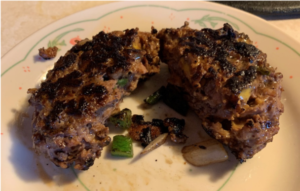
*Side Note – Usually I will take an additional 5 lbs or so of the mixture and just wrap and package that meat up in 1 pound packages to make patties just like this for breakfast or to even mix in with eggs! The best way to wrap meat like this is to tightly wrap it in saran wrap and then again in freezer paper.
Stuff It!
Now that we know we have an awesome delicious product, we can now stuff our meat into the casing! If you are using the meat grinder, make sure that you attach the proper items to the machine. Using the stuffer setup with a grinder takes longer and can be more annoying, but it can be done! Once you get through this and want to do it more often, I highly recommend getting a sausage stuffer for this part of the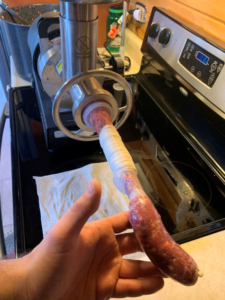 job. It will be much easier and faster, but like I said, we want to accomplish this with as little equipment as possible, so the grinder will do just fine! With the grinder usually comes plastic stuffers. With the plastic stuffers, it is sometimes difficult to shove the casing onto them because it will stick. To combat this, I will usually spray some pam on the plastic stuffer to make the casing slide easier onto it. Take one strand of casing and slide it all the way onto the stuffer and then tie a knot to the end.
job. It will be much easier and faster, but like I said, we want to accomplish this with as little equipment as possible, so the grinder will do just fine! With the grinder usually comes plastic stuffers. With the plastic stuffers, it is sometimes difficult to shove the casing onto them because it will stick. To combat this, I will usually spray some pam on the plastic stuffer to make the casing slide easier onto it. Take one strand of casing and slide it all the way onto the stuffer and then tie a knot to the end.
Now it’s time to add your meat to the top bin and begin stuffing! Turn your grinder on and have at it. I typically stuff the casing to about 2 feet in length (give or take) which usually equates to about a pound. Once you get to the desired length, cut off the casing ensuring you have 2 inches or so of extra length to tie another knot to the back end.
*Side 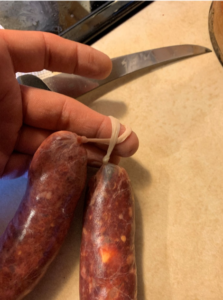 Note – I usually tie the knot with extra length left over to tie the two ends together for hanging. You can also use rope to hang it, but I’ve found this works just as well with out the extra step of tying the string onto the ring of kielbasa. Also, if you are using an oven or are not hanging them to smoke, it really doesn’t matter.Repeat this process until you either run out of mix or run out of casing! If you run out of casing first, you can wrap the extra meat like earlier.
Note – I usually tie the knot with extra length left over to tie the two ends together for hanging. You can also use rope to hang it, but I’ve found this works just as well with out the extra step of tying the string onto the ring of kielbasa. Also, if you are using an oven or are not hanging them to smoke, it really doesn’t matter.Repeat this process until you either run out of mix or run out of casing! If you run out of casing first, you can wrap the extra meat like earlier.
Smoking Time!
Now we are already for the smoker (or oven). You can even package and freeze as is if you’d like at this point and grill it whenever you please. Since I smoke it, I can pull it out of the freezer at any time, let it thaw, and just eat away. But anyways, turn the smoker on and set it to 175° F. If using an oven, set it to the lowest setting and leave the door cracked open just a tad. Once the smoker reaches temperature, add the soaked woodchips and let them go to town for about a half hour. 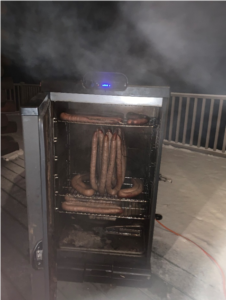 Once smoke starts coming out of the top end and you can smell it, it’s time to add the kielbasa rings. Smoke them for as long as it takes to get them to the appropriate temperature (USDA Temperatures can be looked up online). *Side Note – If using bear, wild hog, or any kind of predator meat it is extremely important that the temperature exceeds the recommended temperature to kill off trichinosis.
Once smoke starts coming out of the top end and you can smell it, it’s time to add the kielbasa rings. Smoke them for as long as it takes to get them to the appropriate temperature (USDA Temperatures can be looked up online). *Side Note – If using bear, wild hog, or any kind of predator meat it is extremely important that the temperature exceeds the recommended temperature to kill off trichinosis.
Throughout this process (8-12 hours) it may be necessary to add more woodchips so be sure to have more soaking just in case. Once the meat reaches the appropriate temperature, remove the rings from the smoker and hang them in a room temperature/cool dry place for about an hour. By doing this, you will create that “shriveled” look as the juices suck into the meat from the outer edges of the casing.
After the rings have rested, they are ready to either eat or package up! I like to package the majority of my meat by using saran wrap and freezer paper. However, in rings like this, it may be best to use a vacuum  sealer to ensure that no air is present within the packaging. Either way, your meat should last in the
sealer to ensure that no air is present within the packaging. Either way, your meat should last in the
freezer much longer than it will likely last once you begin eating it and sharing it with others!
